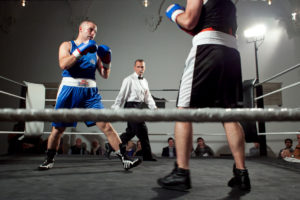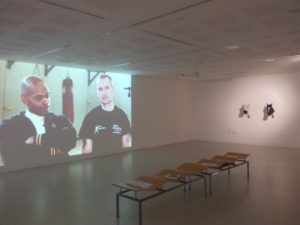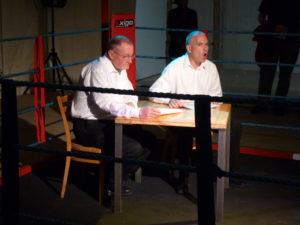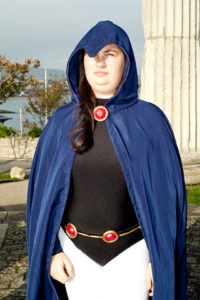Power and Spectatorship
In Laura Eldret’s ‘Power Plays’ we are presented with two studies of the collective actions of individuals brought together by common interests or passions. Rather than offering a glimpse of utopian social cohesion, these works explores how fractures and disjunctions act as a generative social force. Working with groups and individuals, Eldret seeks to simultaneously dramatize aspects of social cohesion and disharmony. She seeks a contradictory goal: to find unity in conflict and conflict in unity. Existing models of such collaborative groups include sports societies, re-enactment or ‘farb’ societies, and groups involved in the production of religious or secular ceremonies and rituals, from choirs to boxing federations. Eldret is also interested in the miscegenation of these performative actions – in mixing up traditions to create new types of ceremonies and events. These crossovers might cut across ancient and modern tradition, collective and idiosyncratic pursuits, and twists in social usage. Here, a song might be a form of self-marketing, and an organized, rule-based fight an act of social bonding. Eldret’s work is marked by variegated sets of specific polarities: groups and individuals, conflict and harmony, original and copy.
To produce Fought – both a live event and a documentary film – Eldret worked with a boxing federation in order to present a ‘re-enactment’ of a match that had taken place two years earlier. The boxers involved are united both by their passion for the sport and by their employment: outside the ring, they are all professional firemen. The audience, meanwhile, consisted of another grouping, being largely drawn from the art world. Indeed, the event itself took place in central London during ‘Frieze week’ in 2011, the much-hyped annual art fair installed in the capital’s Regent’s Park. The video of Eldret’s event explores a variety of tensions and crossovers: between the two groups (boxers and artist professionals), between the individual boxers in the ring (opponents) and outside (colleagues), and between other key individuals and bystanders. Consisting of intercut scenes from the match, and interviews with these various participants from before and after the event, the video captures both the immediacy of the live event and the possible meanings it had for those involved.
For the boxers themselves, for example, the fight offered a chance to showcase their skill (clearly, boxing is not simply brute force). Boxers Ed Haines and Justin Hudson circle around each other; they are a harmonious unit, keyed to each muscular flex. In their pre-fight interviews, they reflect on the common perception of boxers (people often think we have ‘cauliflower ear holes’, says Ed). More reflective still are the federation’s two principal coordinators, Vince Anderson and Dave Waterman. Vince is a poet in waiting, one of life’s philosophers, who compares boxing to Roman gladiatorial battle and Japanese martial arts. Dave is at once the straight-talking foil to Vince’s extravagant speculations, and a source of accurate information on the sport – rather than the art – of boxing. (Dave is a former boxer; Vince is a promoter). For the audience members, who are by and large middle class liberals, the fight was both energizing and confounding. Some recall visiting boxing rings in their youth; others can’t figure out whether violence of this sort can even be considered art.
Fought presents a spectacle both familiar and contradictory: a group of people brought together and united by ritualised conflict. Boxing is itself a contradiction, for it is both irreducibly physical and a synecdoche for the smaller and larger conflicts in political, personal and working life. Boxing, the cliché goes, is an art. Life, we can sometimes think, is like boxing. The more astute writers who have taken on this grand subject have been wise to admit there is a deep problem here. For novelist Joyce Carol Oates, boxing does not fit the categories of being merely brutal (as it is to its detractors), or the noble sport (as it is to many of its defenders). She is similarly keen to avoid boxing as a ‘hellish writterly metaphor’: for her, life might sometimes be like boxing – ‘But boxing is only like boxing’. It is tempting to always think of boxing what it is not (art, politics, chess). The difference between Vince and Dave lies along these lines, with the former boxer Dave consistently rebuffing Vince’s flights of fancy.
But unlike Oates’ short collection of writing On Boxing, Eldret’s film is not actually about boxing per se – and neither is it a metaphor. Fought is about people’s very real relationship with boxing: the culture it produces, the passions it arouses in different groups of people. Eldret is also interested in the possibility of enacting an essentially live event as a ritualised performance. The act of translation between formats, from live event to documentary video, is a key process here. In fact, Fought consists of three distinct elements: the live event, the documentary video, and a subsequent play based on the video. Eldret recently presented this latter version at the Baltic in Gateshead, as part of the museum’s tenth anniversary celebrations. Rather than being a conventional play consisting of a narrative, dialogue and soliloquies, Fought (the play) is a call-and-response song, in which two singers (dressed as referees) enunciate words or brief phrases to describe the pace, drama and meaning of the events. The play is a vocalized version of a boxing match, consisting of bouts (which correspond to the scenes in a conventional play) and a climactic denouement.
In the video Muster, also exhibited in ‘Power Plays’, a motley collection of individuals parade across the screen before pausing and joining a line-up of other participants. Each had responded to an open call by Eldret to star as characters of their own invention within the broad theme of ‘power and service’. Drawn from both science fiction and real life, each individual’s new identity is realized not through action (as is the case in Fought), but through a certain look or apparel. Unlike in Fought, this work is strikingly lacking in human voices. They have, in effect, re-created themselves as an image. Muster was made in Swanage, Dorset, not far from where the artist grew up. In the background, is a view across Swanage’s sea front, and dominating the middle ground are two large classical columns arranged in what may be a loose reference to the Oracle of Delphi. These pillars are as ostentatious and improbable as the cast of characters that, one-by-one fill the circular paved foreground.
First, a man with a pith helmet walks on, his garb an indicator of his belonging to the science fiction sub-genre ‘steampunk’, which draws on both futuristic and anachronistic imagery. Next, a fossil hunter inches her way forward, followed by a steampunk couple, a wet-suit clad figure on a bike, a woman dressed in black masking her face with a piece of paper clutching a human skull (a reference to Shakespeare perhaps?), a caped woman, a man with a clutch of (real) ferrets, a lady steampunk, a woman with a horse’s head, a pirate, and a man in the regalia of a Starfleet Admiral (from Star Trek). Each individual created his or her own identity, with utter freedom to present him or herself as each saw fit. Yet, for all the involvement of the participants in the imagining of the film, they are not its co-authors. Eldret directed each individual to walk on, stand in a specific place, and hold a pose, and was both initiator and author of the project.
While Eldret works with people, she is quite deliberate in avoiding certain platitudes of ‘participation’ that have emerged in contemporary art practice in the past decade or so. Certainly, Eldret’s work suggests a certain degree of disequilibrium between artist and participant. Her material often consists not of things (such as paper, canvas or stone) but of people – or more specifically, groups of people who are absorbed by a common concern. Eldret’s work is a partial dramatization of the fact that an artist ultimately has control over her subjects in the production and presentation of an artwork. There is, it must be stressed, nothing callous or exploitative about this (it is celebratory). Her work is an admission of the fact that in art, ‘collaboration’ and ‘participation’ are contentious terms in art today. Numerous writers and curators, from Claire Bishop to Nicolas Bourriaud and Grant Kester have argued over the terms of collaborative practices. Should it be a model of a possible utopia? Or should it illustrate the tensions of society in order to admit (and even critically exacerbate) those inequalities?
Importantly, those involved in Eldret’s works are offered a certain degree of agency. Participants in Eldret’s videos are offered a chance to present their own stories, narratives and voices beyond their immediate communities. A project undertaken in residence at Camden Arts Centre is also significant in this regard: Song For a Tradesman Choir in which Eldret gathered workmen together to sing a song promoting their trades. Similarly, Muster resulted from an open call to locals to be part of a video project, for which they would also receive a professional photograph of themselves in costume. Fought is primarily an art video, but it also might be shown outside of the gallery context to peers and boxing professionals. Likewise, Eldret relies on the professional skill of photographers and filmmakers to create her works; but her skill as an organizer is perhaps more vital to these works. The contested ‘power’ (to borrow a word from the exhibition’s title) of participants, audience and artist, is, surprisingly not a force of disunity. Rather, it binds these works into a coherent project. It is a contradiction that forms the heart of Eldret’s art.



